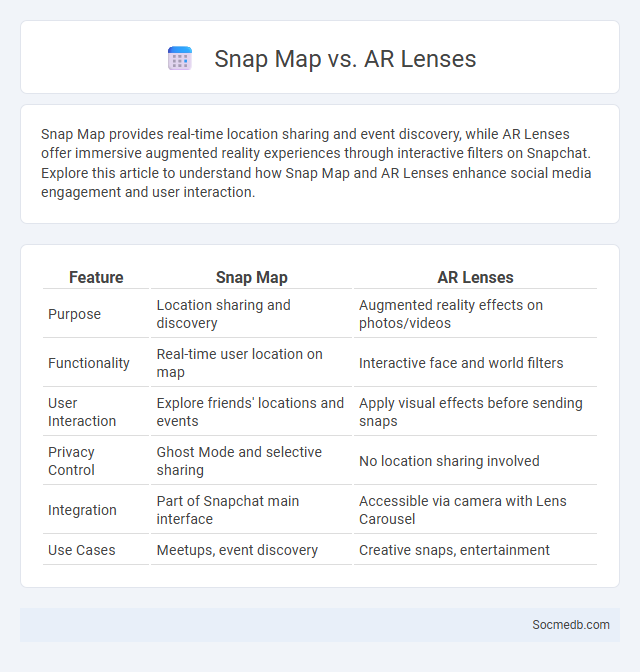
Photo illustration: Snap Map vs AR Lenses
Snap Map provides real-time location sharing and event discovery, while AR Lenses offer immersive augmented reality experiences through interactive filters on Snapchat. Explore this article to understand how Snap Map and AR Lenses enhance social media engagement and user interaction.
Table of Comparison
| Feature | Snap Map | AR Lenses |
|---|---|---|
| Purpose | Location sharing and discovery | Augmented reality effects on photos/videos |
| Functionality | Real-time user location on map | Interactive face and world filters |
| User Interaction | Explore friends' locations and events | Apply visual effects before sending snaps |
| Privacy Control | Ghost Mode and selective sharing | No location sharing involved |
| Integration | Part of Snapchat main interface | Accessible via camera with Lens Carousel |
| Use Cases | Meetups, event discovery | Creative snaps, entertainment |
Introduction to Snap Map, AR Lenses, and Their Unique Features
Snap Map offers a dynamic way to explore real-time activities and events by sharing users' locations on an interactive map, enhancing social connectivity. AR Lenses utilize augmented reality technology to overlay interactive and immersive visual effects on photos and videos, providing creative expression tools with unique animated filters and facial recognition capabilities. These features combine to create a distinctive social media experience that blends geographic sharing with engaging AR interactions.
Snap Map: Real-Time Social Mapping Explained
Snap Map is a dynamic feature of Snapchat that allows users to share their real-time location with friends on an interactive map. This real-time social mapping tool enhances connectivity by displaying user movements, events, and popular spots, enabling spontaneous meet-ups and increased social interaction. The platform prioritizes privacy with customizable settings, ensuring users control who sees their live location on Snap Map.
AR Lenses: Augmented Reality on Snapchat
AR Lenses on Snapchat leverage advanced augmented reality technology to create immersive, real-time visual effects that enhance user interaction and engagement. These lenses use facial recognition and environmental mapping to overlay digital graphics seamlessly onto the physical world, offering personalized and dynamic experiences. Brands and creators capitalize on Snapchat's AR Lenses for marketing campaigns by driving higher user participation and increasing brand visibility.
Comparing Snap Map and AR Lenses: Core Differences
Snap Map offers real-time location sharing and event discovery by displaying friends' positions on an interactive map, enhancing social connectivity through geographic context. AR Lenses provide immersive, augmented reality experiences by overlaying dynamic digital effects on users' photos and videos, emphasizing creative self-expression and entertainment. These core differences highlight Snap Map's focus on spatial interaction versus AR Lenses' emphasis on visual enhancement in social media engagement.
User Experience: Map Navigation vs. Interactive Filters
User experience in social media platforms significantly improves when balancing map navigation and interactive filters, enabling users to discover content with precision and ease. Map navigation offers visual geographic context, which enhances location-based social interactions and event exploration. Interactive filters empower users to tailor content feeds by preferences such as hashtags, topics, or engagement metrics, providing a personalized and efficient discovery process.
Privacy and Security: Snap Map vs. AR Lenses
Snap Map raises privacy concerns by revealing user location in real-time, which can expose users to unwanted tracking or stalking risks. AR Lenses prioritize user security by processing augmented reality effects locally or anonymizing data before cloud interaction, minimizing personal information exposure. Both features require users to adjust privacy settings carefully to balance social engagement and personal security effectively.
Content Creation: Storytelling with Snap Map and AR Lenses
Content creation on social media is revolutionized by storytelling techniques using Snap Map and AR Lenses, enabling users to share immersive experiences with interactive geotagged content. Snap Map allows creators to connect stories to specific locations, enhancing real-time engagement through localized visuals and community-driven narratives. AR Lenses add a layer of dynamic, augmented reality effects that personalize user-generated content, increasing viewer interaction and driving higher social media reach.
Impact on Social Connectivity and Engagement
Social media platforms significantly enhance social connectivity by enabling users to maintain relationships across distances and engage with diverse communities in real-time. Your ability to share experiences, ideas, and emotions instantly fosters deeper emotional bonds and collaborative interactions, which traditional communication methods cannot match. This increased engagement drives a dynamic exchange of information, promoting inclusivity and expanding social networks globally.
Brand and Marketing Opportunities: Which Tool Wins?
Social media platforms like Instagram, LinkedIn, and TikTok offer unique brand and marketing opportunities tailored to different industries and target audiences. Instagram excels in visual storytelling and influencer collaborations, while LinkedIn is powerful for B2B marketing and professional networking; TikTok boosts brand visibility through viral, creative content. Understanding your brand's goals and audience helps you choose the tool that maximizes marketing ROI and engagement.
Conclusion: Choosing Between Snap Map and AR Lenses
Selecting between Snap Map and AR Lenses depends on user preferences and social media goals; Snap Map offers location-based interaction and real-time updates, enhancing social connectivity through geotagging. AR Lenses provide immersive, creative experiences by overlaying digital effects on photos and videos, boosting engagement with visually dynamic content. Evaluating the intended audience and content style helps determine the most effective tool for maximizing social media impact.
 socmedb.com
socmedb.com